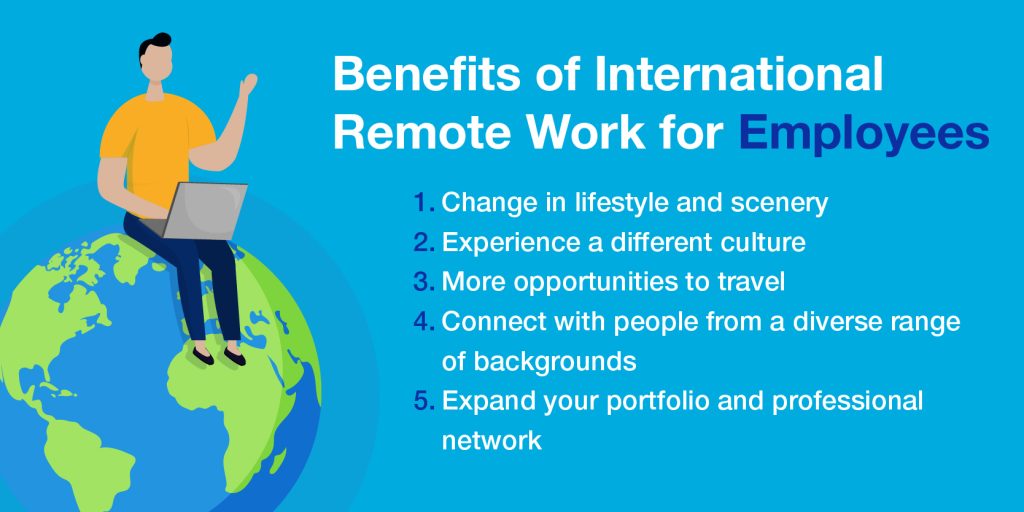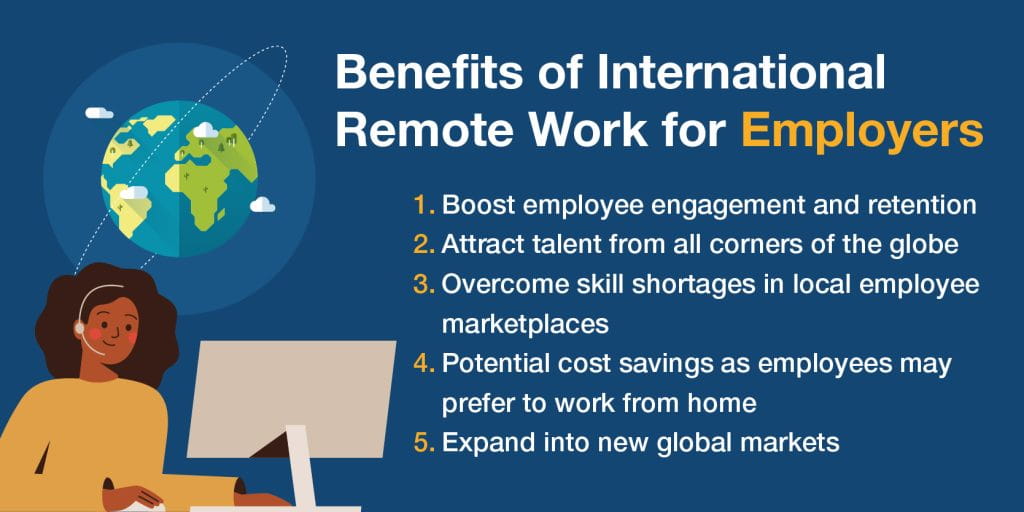
The recent boom in the number of workers across Australia shifting to a work-from-home model has been one of the biggest shake-ups to the labour market in decades.
Working from home has become extremely popular in recent years, improving the work-life balance for employees, while also boosting productivity for businesses. But working from home is just one branch of the remote work model. This can also cover international remote working.
In essence, international remote working is a geographical extension of typical remote work where people operate virtually from another country. While companies used to be very reluctant to allow employees to move around the globe, it has become common for many mobile workers since the pandemic, as part of the concept of a globally distributed workforce.
The phenomenon usually presents in one of two ways – either an employee works for an international company in their home country; or workers pick up their existing job and take it with them as part of a move overseas.
While hard data is tough to come by on how many Aussies are working remotely abroad, more countries are rolling out visa offerings to entice them. Among a long list of countries that offer a form of digital nomad visas – travel documentation specifically aimed at workers operating outside their home territory – include the Czech Republic, United Arab Emirates, Estonia, Germany, Thailand, Italy, Spain, Indonesia, and Brazil.
Many countries are going to great lengths to secure foreign labour. Portugal has even gone so far as to offer a two-year renewable residence visa for workers able to prove they’re working a remote job throughout their stay.
But what are the advantages for employees and employers looking abroad? In this guide, you’ll uncover the pros and cons of international remote work, as well as some handy tips if you or your business are venturing into this type of employment.

What are the benefits of international remote work for employees?
There are many reasons for employees to consider international remote work, with lifestyle being a key attraction. International remote allows you to experience a different country and culture for an extended period, versus a typical nine-to-five position that usually comes with a standard month of annual leave.
International remote work is also a great way to meet new people from a diverse range of backgrounds. It also gives you the chance to make professional and social connections with travellers and expats from all walks of life.
There are often cost-of-living benefits to remote international work, depending on the far-flung location you’re working from. However, it is highly recommended to speak with a finance professional and research the taxation rules for your chosen country.
For international remote workers based in Australia, the advantages of such an arrangement are often transformative. It may be that there are more jobs outside your local market, meaning you can potentially tap into new and rewarding professional opportunities.

What are the benefits of international remote work for employers?
There are also benefits for employers when hiring international remote workers or letting staff work from anywhere. For instance, a recent study by the London School of Economics found that having a company policy that facilitates remote working, whether from inside or outside national borders, can help boost employee engagement and retention. The same study also suggested these policies can assist in curbing job burnout, especially among younger workers.
Another advantage for employers is talent attraction. A policy that lets domestic candidates work from anywhere can attract strong talent.
Similarly, it can have a positive impact on talent retention. With a company’s performance closely tied to its ability to limit employee turnover – the number of people who exit jobs within a given period – a remote policy has shown to help. According to Employment Hero, while over half (55%) of Australians are working remotely, at least partially, 50% of workers would rather quit than be in the office full-time.
Making the most of an international remote workforce can be a relatively easy way to expand your talent pool beyond national borders. Tapping into an overseas marketplace may also mean that employees are able to work from home and may not be required to attend a traditional office space. Bearing this in mind, companies will need to ensure the WFH environment of their employees is ergonomic and safe.
It’s important for companies considering an overseas expansion to give existing employees the opportunity to work remotely. This flexible approach gives staff the chance to work abroad in a new market while building a local network as part of the company establishing its expanded presence.
There are also other organisational benefits. According to Harvard Business Review, employees who temporarily worked abroad often returned to their home office with new learnings. Specifically, more diversity of thought and better acceptance of other ways of approaching work and life.

What are the challenges of international remote work?
While there are multiple advantages to international remote work, challenges do exist. These drawbacks can apply to both employers and employees, such as the issue of divergent time zones, especially if a worker is operating from the other side of the globe.
For example, if an Australian employer based in Sydney engages a worker in New York City, the start of the Aussie business day is close-of-business in NYC. This can make working hours and communicating difficult, depending on the nature of the work being undertaken remotely.
Companies engaging workers based overseas also need to be aware of any language or cultural differences they may encounter. As management consultancy McKinsey noted, with companies now using international remote workers, workplace environments are increasingly diverse. In response to this, staff and managers need to be both proficient in digital platforms and be aware of any language or cultural differences. By prioritising cultural awareness, this ensures all team members are set up for success and supports efficient ways of working.
Another thought to ponder is whether a physical workplace needs to be arranged. This is a key consideration as many remote international workers perform duties without a physical office – be it at home, a café or a co-working space.
Regardless of where and how remote workers are undertaking their tasks, organisations will need to ensure they have the right equipment to effectively carry out duties. In fact, the World Economic Forum has pointed to surging demand for home office equipment and larger homes since the onset of the pandemic.
It’s also key to ensure that any tech or office tools provided meet the needs of staff, as well as the needs of the organisation. For instance, many teams will need to ensure they have the right equipment to reliably scan and digitise information, quickly and efficiently.
Optical Character Recognition (OCR) software enables staff to scan and turn physical documents into digital files that can be easily shared over a global database. Devices like the Brother Desktop Document Scanner ADS-3300W, for example, allow users to quickly and effortlessly scan and share multiple files between departments and clients across the globe.

Another challenge for international remote workers is the absence of physical interaction with colleagues. This can lead to social isolation given the number of hours spent without any human contact. While there’s no consensus on the issue, some research from the Massachusetts Institute of Technology revealed that remote work can lead to a reduced sense of belonging to an organisation.
What to look out for
With the growth of international remote working being a relatively recent phenomenon, laws and regulations around it can be tricky to come to grips with. As experts point out, while cross-border virtual working presents opportunities for both employers and workers, it can also trigger compliance issues that many companies don’t even know exist.
An area companies may need to consider – by seeking legal advice – is on the topic of employment law. Legal complexity can arise related to international remote workers on issues from hiring to termination, depending on where companies and employees are based.
Other compliance challenges that may need to be navigated include health and safety obligations, redundancy payouts, performance monitoring, amendments in terms and conditions of employee contracts, as well as cyber security and data risks. Companies may also be required by local laws to provide equipment, such as desk chairs, computers and tech to their overseas-based workers, according to professional services firm PwC.
Organisations with global remote workers will also have to come to agreement on working hours, or on how work will be completed, for instance, on a per-project basis. Likewise, companies are urged to look at whether a worker based overseas will be engaged as an employee, contractor, or some other formal arrangement. Different countries have different workplace rules, so businesses should seek professional advice on what is the best course of action.
Tips to find international remote workers
To find top-tier talent, it’s critical to tap into global networks. International job boards, social networks and search engines are great ways of advertising remote positions and can put your company into contact with remote job seekers worldwide.
According to We Work Remotely, which describes itself as the largest remote work community in the world, getting the best remote global talent starts with a strong job description. When writing a remote job ad, highlight an accurate description of the remote policy; why the job is remote; and time zone requirements. Don’t forget to include travel requirements, the corporate culture and how a remote worker will fit into the role.
While job boards are great for volume, social media sites can be a more targeted way to access high-quality international candidates. LinkedIn is a solid first port of call as it claims to be the world’s largest professional network.
In addition to the significant reach of this platform, LinkedIn also enables searchers to refine candidates by location, down to job postings with a particular city as the location. There’s even an option to add ‘remote’ to the location field if location is flexible.
The next step might be to contact universities and colleges overseas to tap into remote graduate-level talent, with certain educational institutions potentially specialising in the fields you’re looking for.
Consider reaching out to career development offices of the top tertiary institutions in overseas markets that make business sense, or email specific departments to set up direct contacts with graduates that may fit the bill.
At the end of the day, while it’s still emerging as a workplace trend, international remote work can be a major win-win for both employers and workers.
Other articles you may be interested in:





